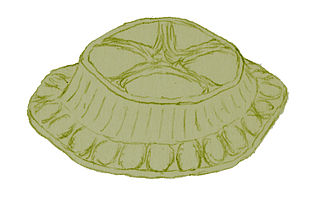 W
WArkarua adami is a small, Precambrian disk-like fossil with a raised center, a number of radial ridges on the rim, and a five-pointed central depression marked with radial lines of 5 small dots from the middle of the disk center. Fossils range from 3 to 10 mm in diameter.
 W
WChancelloria is a genus of early animals known from the Middle Cambrian Burgess Shale, the Comley limestone, the Wheeler Shale, the Bright Angel Shale and elsewhere. It is named after Chancellor Peak. It was first described in 1920 by Charles Doolittle Walcott, who regarded them as one of the most primitive groups of sponges. This appears unlikely, and it is currently placed in the enigmatic group Coeloscleritophora. 178 specimens of Chancelloria are known from the Greater Phyllopod bed, where they comprise 0.34% of the community.
 W
WCharniodiscus is an Ediacaran fossil that in life was probably a stationary filter feeder that lived anchored to a sandy sea bed. The organism had a holdfast, stalk and frond. The holdfast was bulbous shaped, and the stalk was flexible. The frond was segmented and had a pointed tip. There were two growth forms: one with a short stem and a wide frond, and another with a long stalk, elevating a smaller frond about 50 centimetres (20 in) above the holdfast. While the organism superficially resembles the sea pens (cnidaria), it is probably not a crown-group animal.
 W
WCyclomedusa is a circular fossil of the Ediacaran biota; it has a circular bump in the middle and as many as five circular growth ridges around it. Many specimens are small, but specimens in excess of 20 cm are known. The concentric disks are not necessarily circular, especially when adjacent individuals interfere with each other's growth. Many radial segment lines — somewhat pineapple-like — extend across the outer disks. A few specimens show what might be a stem extending from the center in some direction or other.
 W
WDinomischus is a rare fossil animal from the Cambrian period. It reached 20 mm in height, was attached to the sea floor by a stalk, and looked loosely like a flower. The cup-shaped body at the top of the stalk probably fed by filtering the surrounding seawater, and may have created a current to facilitate this. Its mouth and anus sat next to one another.
 W
WEchmatocrinus is a Cambrian animal which resembles a crinoid or an octocoral. Its exact taxonomy is still a subject of debate. It is known only from the Burgess shale. 5 specimens of Echmatocrinus are known from the Greater Phyllopod bed, where they comprise < 0.1% of the community.
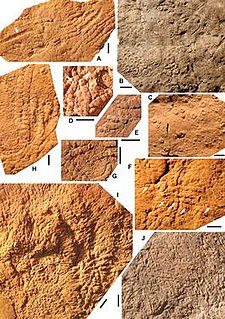 W
WFunisia is a genus containing the single species F. dorothea, a fossil upright worm-like animal from the Ediacaran biota discovered in Australia. Funisia stood about 0.3 metres tall. Because individuals grew in dense collections of animals the same age, it is believed to have reproduced sexually. Although the evolution of sex took place before the origin of animals, and evidence of sexual reproduction is observed in red algae 1,200 million years ago, Funisia is one of the oldest known animals for which there is evidence of sexual reproduction. Its relationship to other animals is unknown, but it may belong within the Porifera (sponges) or Cnidaria, or it may have been a basal metazoan. The genus and species were described in a 2008 paper.
 W
WInaria is an Ediacaran fossil. It is found in the Chace Range in Australia, and the White Sea area in Russia.
 W
WKimberella is an extinct genus of bilaterian known only from rocks of the Ediacaran period. The slug-like organism fed by scratching the microbial surface on which it dwelt in a manner similar to the gastropods, although its affinity with this group is contentious.
 W
WMicroschedia is an enigmatic fossil bilaterian known from four specimens from Lower Cambrian Amouslek Formation deposits in Morocco.
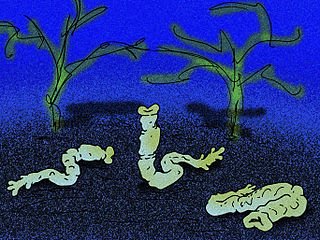 W
WOesia disjuncta is a monospecific genus known from the Middle Cambrian Burgess Shale. 1147 specimens of Oesia are known from the Greater Phyllopod bed, where they comprise 2.18% of the community. Despite some similarities to the chaetognaths, its affinity is unknown, though recent data suggest it may be affiliated with hemichordates.
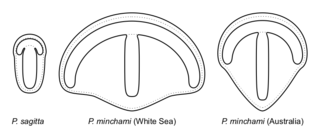 W
WParvancorina is a genus of shield-shaped bilaterally symmetrical fossil animal that lived in the late Ediacaran seafloor. It has some superficial similarities with the Cambrian trilobite-like arthropods.
 W
WPollingeria is a problematic genus of animals of the Middle Cambrian Burgess Shale. 3080 specimens of Pollingeria are known from the Greater Phyllopod bed, where they comprise 5.85% of the community.
 W
WPortalia mira is a fossil from the Burgess Shale that was originally described by Charles Walcott as a holothurian echinoderm. A later interpretation by F. Madsen in 1957 posits P. mira as a sponge.
 W
WProtonympha is a form genus for problematic fossils of Devonian age in New York. It has been of special interest because of its morphological similarity with the iconic Ediacaran fossil Spriggina, and may have been a late surviving vendobiont.
 W
WRutgersella truexi is a form species for problematic fossils of Early Silurian age in Pennsylvania. It has been of special interest because of its morphological similarity with the iconic Ediacaran fossil Dickinsonia, and may have been a late surviving vendobiont.
 W
WTemnoxa molluscula is a small creature approximately 8 mm wide found in the Ediacaran period in Russia. The Temnoxa has a resemblance to a vertically cut penny bun mushroom. Due to the lack of information regarding the fossils of this organism, researchers are unable to place Temnoxa molluscula into any known phylum. The genus was originally discovered by Russian paleontologist Andrey Yu. Ivantsov in 2004.
 W
WThectardis avalonensis is a triangular-shaped member of the Ediacaran biota, dating from 575 to 565 million years ago. The organism took the form of an elongated cone with a central depression, and its apex was anchored to the substrate.
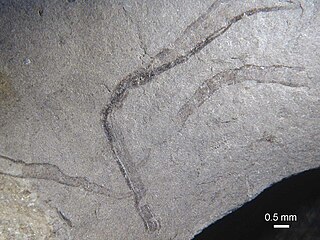 W
WTorellella is a genus of problematic tubicolous fossils. They have slightly conical, phosphatic tubes with elliptical cross-section. Their fossils are known from the Cambrian.
 W
WTribrachidium heraldicum is a tri-radially symmetric fossil animal that lived in the late Ediacaran (Vendian) seas. In life, it was hemispherical in form. T. heraldicum is the best known member of the extinct group Trilobozoa.